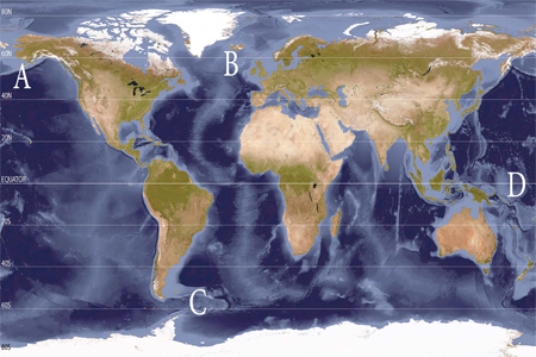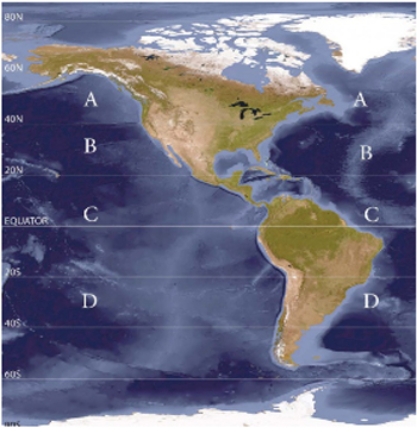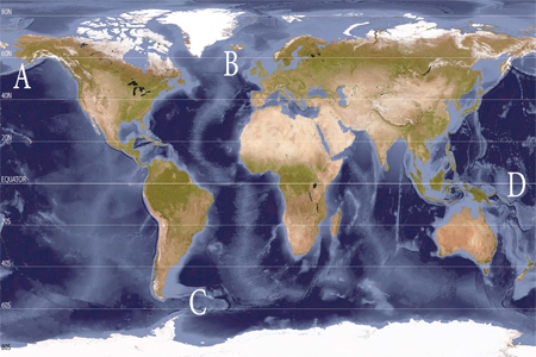A) Walker Cell deflection causes cooler surface waters to deflect to the northwest, causing warmer waters to replace the
Dispersing surface water.
B) Coriolis deflection causes warmer surface waters to deflect to the southwest, causing warmer waters to replace the
Dispersing surface water.
C) Coriolis deflection causes warmer surface waters to deflect to the northwest causing deeper, cooler waters to replace the dispersing surface water.
D) Coriolis deflection causes cooler surface waters to deflect to the east, causing deeper, cooler waters to replace the
Dispersing surface water.
F) A) and B)
Correct Answer

verified
Correct Answer
verified
Multiple Choice
Warm oceanic pools form in areas of
A) rising, unstable air where much latent heat is released.
B) descending, stable air where much latent heat is released.
C) warm water is forced to the surface due to upwelling.
D) thermoclines near the surface when the sun is closer to the earth.
F) A) and C)
Correct Answer

verified
Correct Answer
verified
Multiple Choice
When the Kelvin wave hits the coast of South America
A) the thermocline is at a much more shallow level as cold water is concentrated at the surface.
B) the thermocline is found much deeper as warm water is concentrated at depth.
C) the thermocline is at a much more shallow level as warm water is concentrated at depth.
D) the thermocline is at a much more shallow level as cold water is concentrated at depth.
F) A) and B)
Correct Answer

verified
Correct Answer
verified
Multiple Choice
Which of the following locations is associated with sinking of cold saline waters forming the North Atlantic Deep Waters (NADW) ? 
A) A
B) B
C) C
D) D
F) None of the above
Correct Answer

verified
Correct Answer
verified
Multiple Choice
All of the following are cold currents, EXCEPT:
A) North Equatorial Current.
B) Humbolt Current.
C) California Current.
D) Benguela Current.
F) All of the above
Correct Answer

verified
Correct Answer
verified
Multiple Choice
The circulation of the Bermuda-Azores high pressure system which influences the North Atlantic Oscillation (NAO) is
A) clockwise and inward.
B) clockwise and outward.
C) counterclockwise and inward.
D) counterclockwise and outward.
F) A) and B)
Correct Answer

verified
Correct Answer
verified
Multiple Choice
In the Pacific Ocean, Walker cell circulation is associated with
A) eastward surface winds moving away from the Pacific warm pool.
B) westward surface winds moving away from the Pacific warm pool.
C) westward surface winds moving toward the Pacific warm pool.
D) eastward surface winds moving toward the Pacific warm pool.
F) A) and B)
Correct Answer

verified
Correct Answer
verified
Multiple Choice
Where on the map is the center of high pressure influencing ocean currents with clockwise circulation? 
A) A
B) B
C) C
D) D
F) C) and D)
Correct Answer

verified
Correct Answer
verified
Multiple Choice
In regard to ocean salinity, temperature, and density:
A) heavy tropical rainfall increases salinity and decreases density
B) high evaporation in subtropical waters decreases salinity and increases density
C) ice formation in polar zones decreases salinity and density
D) ice formation in polar zones increases salinity and density
F) A) and B)
Correct Answer

verified
Correct Answer
verified
Multiple Choice
Which of the following locations is associated with a zone of upwelling for the Antarctic Bottom Waters (AABW) ? 
A) A
B) B
C) C
D) D
F) All of the above
Correct Answer

verified
Correct Answer
verified
Showing 61 - 70 of 70
Related Exams